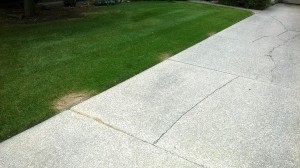
Weeds, they are very opportunistic. If they find a place to grow, they will take it. Many times it is not where we want any plant, desired or weed, to grow. So what do we do? We control the weed with a Round Up-like product. Excellent, but…sometimes things do not go as planned, and we plan kill more than we want with the Round Up…round up damage, bummer.
Many times round up damage is found in the lawn near cracks in the pavement, along landscape beds, and occasionally in random spots where the sprayer may have leaked. Since Round Up is a non-selective herbicide, it does not care what it touches because it will harm most plants.
Glyphosate, the active ingredient in Round Up, is actually a plant growth regulator. It stops the photosynthesis process, and ultimately starves the plant. Larger plants can tolerate very small amounts of glyphosate. However it is best to avoid contacting desirable plants with glyphosate, including your grass near the cracks in the driveway.
Now if some Round Up does make it onto something desirable, and the Round Up is still wet, you can try to wash the plant off with water to remove as much of the Round Up as possible to lessen any damage. Then you will have to wait and see what becomes damaged.
When you do not realize that the Round Up made its way onto something desirable, and it dies out, then that plant is done for. Landscape plants will need to be pruned to remove the damage, or replaced if the entire plant is dead. With turf grass, the grass is dead, but the surrounding undamaged grass will eventually fill in the hole created by Round Up.
It is best to avoid having Round Up touch something desired. Care should always be used to avoid Round Up damage.